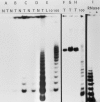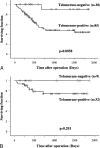Prognostic impact of telomerase activity in non-small cell lung cancers
- PMID: 10561097
- PMCID: PMC1420927
- DOI: 10.1097/00000658-199911000-00015
Prognostic impact of telomerase activity in non-small cell lung cancers
Abstract
Objective: To evaluate the clinical significance of telomerase activity, particularly in terms of prognostic impact, in non-small cell lung cancer (NSCLC).
Summary background data: Telomerase activity has been found in various tissues. The activation of telomerase is considered necessary for the immortalization of human tumor cells, including NSCLC.
Methods: The authors studied 103 NSCLC specimens using a polymerase chain reaction based on a telomeric repeat amplification protocol assay.
Results: Telomerase activity was detected in 85 (82.5%) of 103 NSCLC specimens but in none of the paired normal lung tissue specimens. More cases of positive telomerase activity were observed in the group with advanced disease and in the group with poorly differentiated tumors. Such factors as the mean age at surgery, sex, smoking, histologic type, and size of tumor extension did not correlate with the telomerase activity. The Kaplan-Meier survival curves in all patients with NSCLC demonstrated that patients with telomerase-positive tumors survived for a significantly shorter period than those with a telomerase-negative tumor (p = 0.0058). According to a multivariate analysis, telomerase activity was identified as an independent prognostic factor (RR = 8.62, p = 0.035).
Conclusions: Telomerase activity was one of the most important prognostic factors in patients with NSCLC, and its potential prognostic implication was independent of tumor stage.
Figures


Similar articles
-
Telomerase activity as a prognostic indicator in stage I non-small cell lung cancer.Clin Cancer Res. 1999 Aug;5(8):2077-81. Clin Cancer Res. 1999. PMID: 10473089
-
Increased human telomerase reverse transcriptase (hTERT) mRNA expression but not telomerase activity is related to survival in curatively resected non-small cell lung cancer.Anticancer Res. 2009 Apr;29(4):1157-62. Anticancer Res. 2009. PMID: 19414359
-
Telomerase activity in transthoracic fine-needle biopsy aspirates from non-small cell lung cancer as prognostic factor of patients' survival.Lung Cancer. 2008 Jul;61(1):97-103. doi: 10.1016/j.lungcan.2007.10.017. Epub 2007 Dec 3. Lung Cancer. 2008. PMID: 18063440
-
Study of telomerase activity in pleural lavage fluid specimens in patients with non-small-cell lung cancer and its clinical significance.Eur J Cardiothorac Surg. 2009 Sep;36(3):460-4. doi: 10.1016/j.ejcts.2009.03.057. Epub 2009 Jun 6. Eur J Cardiothorac Surg. 2009. PMID: 19502078
-
Tumorigenic effect of TERT and its potential therapeutic target in NSCLC (Review).Oncol Rep. 2021 Aug;46(2):182. doi: 10.3892/or.2021.8133. Epub 2021 Jul 19. Oncol Rep. 2021. PMID: 34278503 Review.
Cited by
-
Characterization of the T cell receptor repertoire and melanoma tumor microenvironment upon combined treatment with ipilimumab and hTERT vaccination.J Transl Med. 2022 Sep 11;20(1):419. doi: 10.1186/s12967-022-03624-z. J Transl Med. 2022. PMID: 36089578 Free PMC article. Clinical Trial.
-
Expression of VEGF, HGF, IL-6, IL-8, MMP-9, Telomerase in Peripheral Blood of Patients with Head and Neck Squamous Cell Carcinoma.Clin Exp Otorhinolaryngol. 2009 Dec;2(4):186-92. doi: 10.3342/ceo.2009.2.4.186. Epub 2009 Dec 31. Clin Exp Otorhinolaryngol. 2009. PMID: 20072693 Free PMC article.
-
Telomerase as a Target for Therapeutic Cancer Vaccines and Considerations for Optimizing Their Clinical Potential.Front Immunol. 2021 Jul 5;12:682492. doi: 10.3389/fimmu.2021.682492. eCollection 2021. Front Immunol. 2021. PMID: 34290704 Free PMC article. Review.
-
Telomerase activity in periampullary tumors correlates with aggressive malignancy.Ann Surg. 2001 Sep;234(3):344-50; discussion 350-1. doi: 10.1097/00000658-200109000-00008. Ann Surg. 2001. PMID: 11524587 Free PMC article.
-
Durable and dynamic hTERT immune responses following vaccination with the long-peptide cancer vaccine UV1: long-term follow-up of three phase I clinical trials.J Immunother Cancer. 2022 May;10(5):e004345. doi: 10.1136/jitc-2021-004345. J Immunother Cancer. 2022. PMID: 35613827 Free PMC article.
References
-
- Blackburn EH. Structure and function of telomeres. Nature 1991; 350:569–573. - PubMed
-
- Zakian VA. structure and function of telomeres. Annu Rev Genet 1989; 23:579–604. - PubMed
-
- Harley CB, Futcher AB, Grieder CW. Telomeres shorten during aging of human fibroblasts. Nature 1990; 345:458–460. - PubMed
-
- Hastie ND, Dempster M, Dunlop MG, et al. Telomere reduction in human colorectal carcinoma and with aging. Nature 1990; 346:866–868. - PubMed
MeSH terms
Substances
LinkOut - more resources
Full Text Sources
Medical

